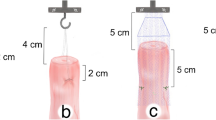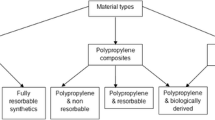Abstract
Female urinary incontinence and pelvic organ prolapse are common conditions. The aim of this study was to assess the biomechanical properties of raw meshes commonly used in pelvic floor surgery, particularly the effects of cyclical loading on these meshes. The material properties of nine different types of surgical meshes were examined using uniaxial tensile tests. The strength and extensibility of the mesh designs differed considerably. Most mesh types exhibited curvilinear loading curves. Cyclical loading of mesh samples produced significant permanent deformation in all mesh designs. This non-recoverable extension ranged from about 8.5% to 19% strain. Hysteresis also varied considerably between materials from 30% to 85%. All mesh groups tested for their biomechanical properties displayed differences in results for failure load, stiffness, non-recoverable extension and hysteresis.


Similar content being viewed by others
References
Olsen AL, Smith VJ, Bergstrom JO, Colling JC, Clark AL (1997) Epidemiology of surgically managed pelvic organ prolapse and urinary incontinence. Obstet Gynecol 89:501–506
Weber AM, Walters MD, Piedmont MA et al (2001) Anterior colporrhaphy: a randomized trial of three surgical techniques. Am J Obstet Gynecol 185:1299–1306
Baessler K, Maher CF (2006) Mesh augmentation during pelvic-floor reconstructive surgery: risk and benefits. Curr Opin Obstet Gynecol 18:560–566
Dietz HP, Vancaillie P, Svehla M, Walsh W, Steensma AB, Vancaillie TG (2003) Mechanical properties of urogynecologic implanted materials. Int Urogynecol J 14:239–243
Afonso JS, Martins PALS, Girao MJB, Natal Jorge RM, Ferreira AJM, Mascarenhas T et al (2008) Mechanical properties of polypropylene mesh used in pelvic floor repair. Int Urogynecol J 19:375–380
Cosson M, Debodiance P, Boukerrou M, Chauvet MP, Lobry P, Crepin G, Ego A (2003) Mechanical properties of synthetic implants used in the repair of prolapse and urinary incontinence in women: which is the ideal material? Int urogynecol J 14:169–178
Ettema GJC, Goh JTW, Forwood MR (1998) A new method to measure elastic properties of plastic-viscoelastic connective issue. Med Eng Phys 20:308–314
Goh JTW (2002) Biomechanical properties of prolapsed vaginal tissue in pre- and postmenopausal women. Int Urogynecol J 13:76–79
Bennett MB, Ker RF, Dimery NJ, Alexander R (1986) Mechanical properties of carious mammalian tendons. J Zool, Lond 209:537–548
Maganaris CN, Paul JP (2000) Hysteresis measurements in intact human tendon. J Biomech 33(12):1723–1727
Belle J, Brodsky B, Berman HM (1995) Hydration structure of a collagen peptide. Structure 3:893–906
Robins SP, Shimokomaki M, Bailey AJ (1973) The chemistry of the collagen cross-links. Age-related changes in the reducible components of intact bovine collagen fibres. Biochem J 131:771–780
Rubod C, Boukerrou M, Brieu M, Jean-Charles C, Dubois P, Cosson M (2008) Biomechanical properties of vaginal tissue: preliminary results. Int Urogynecol J 19:811–816
Goh JTW (2003) Biomechanical and biochemical assessment for pelvic organ prolapse. Curr Opin Obstet Gynecol 15:391–394
Amid PK (1997) Classification of biomaterials and their related complication in abdominal wall hernia surgery. Hernia 1:15–21
Funding
No funding was received.
Conflicts of interest
None.
Author information
Authors and Affiliations
Corresponding author
Rights and permissions
About this article
Cite this article
Krause, H., Bennett, M., Forwood, M. et al. Biomechanical properties of raw meshes used in pelvic floor reconstruction. Int Urogynecol J 19, 1677–1681 (2008). https://doi.org/10.1007/s00192-008-0711-y
Received:
Accepted:
Published:
Issue Date:
DOI: https://doi.org/10.1007/s00192-008-0711-y




